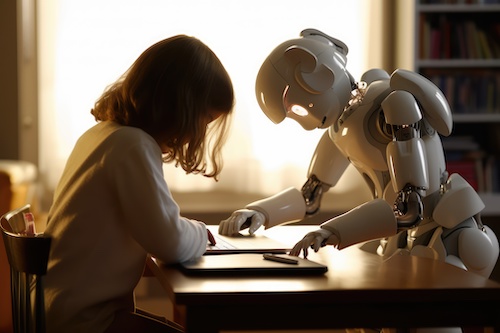Key points:
- AI has exploded, and its potential in education is nearly limitless
- AI enables increased personalization and relieve teachers of burdensome tasks
- See related article: 5 ways I’ve leveraged AI in my English classroom
- For more news on AI in education, visit eSN’s Digital Learning page
- Everything You Need To Know About AI In Education
By now, we hear the term “artificial intelligence” more than a few times a day. But despite the stereotypical sci-fi depictions of AI, it has a legitimate place in today’s classrooms.
Innovative educators and students are finding new ways to integrate AI into teaching and learning every day. Teachers can spend more one-on-one time with students when they use AI to quickly complete tedious tasks. Students, on the other hand, learn how to critically evaluate information and learn about biases when they analyze information coming from generative AI sources.
Here are 5 ways educators are incorporating AI into the classrooms right now:
1. This English teacher created a project-based scenario: The students were attorneys for a law firm, and the teacher is their client, bringing them this challenge: She is thinking about investing in ChatGPT. Based on their understanding and the research they’d conduct during The Crucible unit, should she? What would be the implications? The upsides and the down? Typically, at the end of a unit on The Crucible, she asks students to put various characters on trial, backing up their ideas with plenty of original evidence. This time around, she wanted them to also put ChatGPT on trial. What are its strengths and opportunities, its weaknesses and threats?
2. These Florida-based teachers are using AI to prioritize student-centered activities: Every student needs something slightly different to learn well. When we have tools as teachers that allow us to meet those individualized needs and support the whole student, we know that learning improves. We can now use AI to customize activities that support mental health, give students more ownership over their own learning, and even provide more individualized, responsive tutoring. Your students will likely see AI showing up in their classrooms this year in ways that put them in the driving seat and help make learning feel directed precisely at them, their needs, and their interests.
3. This educator posits that ChatGPT is now a part of learning, and teachers must accept it–with a few conditions: It is time for educators to treat ChatGPT as an unreliable partner in all assignments and to provide a way for students to let us know how much help they received. He specifies an unreliable partner because there is no way to know where ChatGPT got its information for any single response. It uses a mathematical model of likely words, not research. It’s basically auto-complete on steroids. ChatGPT is like a classmate who has read extensively and is really confident about everything they say but can’t remember exactly where they got their information from. It could be an academic publication or it could be a conspiracy website. And that is how we should treat it – a partner who sounds like they know what they are talking about but still needs to be fact-checked.
4. A higher-ed faculty member offers insights on how to determine if generative AI has been used in assignments: Instructors at all levels should consider certain criteria to help them determine whether text-based submissions were student or AI-generated. Lack of personal experiences or generalized examples are a potential sign of AI-generated writing–for instance, “My family went to the beach in the car” is more likely to be AI-generated than “Mom, Betty, and Rose went to the 3rd Street beach to swim.” Instructors should look for unusual or complete phrases that a student would not normally employ–a high school student speaking of a lacuna in his school records might be a sign the paper was AI-generated.
5. This school leader uses AI to help students learn history by having life-like conversations with tech-powered versions of Socrates, Gandhi, and Dr. Martin Luther King. Students can learn about gravity by chatting with an AI-powered version of Sir Isaac Newton. They can learn about art from Frida Kahlo and about WW2 by chatting with a teenage version of Anne Frank. This level of engagement was unheard of before now.
- Friday 5: Virtual field trips - April 26, 2024
- Google, MIT RAISE launch no-cost AI training course for teachers - April 26, 2024
- 4 ways to support work-based learning - April 23, 2024

